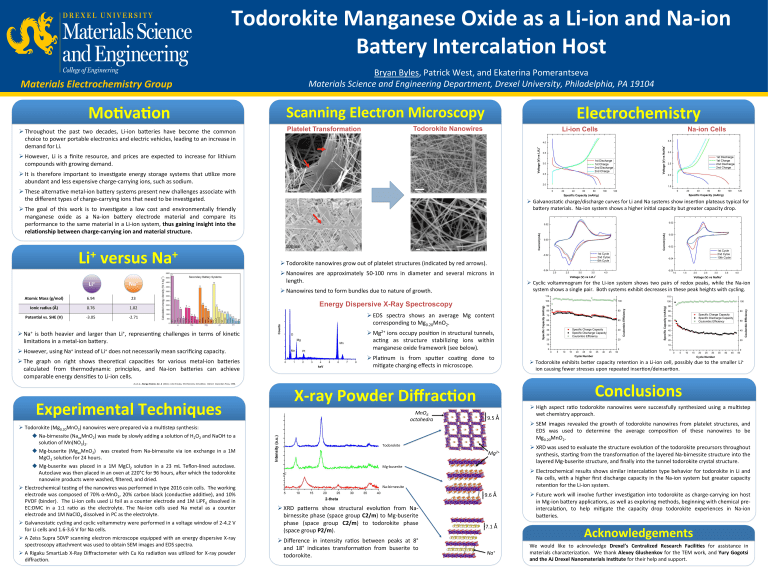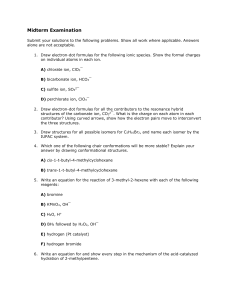Document 11129411

Materials Electrochemistry Group
Mo:va:on
Ø Throughout the past two decades, Li-‐ion ba@eries have become the common choice to power portable electronics and electric vehicles, leading to an increase in demand for Li.
Ø However, Li is a finite resource, and prices are expected to increase for lithium compounds with growing demand.
Ø It is therefore important to inves=gate energy storage systems that u=lize more abundant and less expensive charge-‐carrying ions, such as sodium.
Ø These alterna=ve metal-‐ion ba@ery systems present new challenges associate with the different types of charge-‐carrying ions that need to be inves=gated.
Ø The goal of this work is to inves=gate a low cost and environmentally friendly manganese oxide as a Na-‐ion ba@ery electrode material and compare its performance to the same material in a Li-‐ion system,
thus gaining insight into the rela:onship between charge-‐carrying ion and material structure.
Todorokite Manganese Oxide as a Li-‐ion and Na-‐ion
Ba5ery Intercala:on Host
Bryan Byles, Patrick West, and Ekaterina Pomerantseva
Materials Science and Engineering Department, Drexel University, Philadelphia, PA 19104
Platelet Transformation Todorokite Nanowires
Electrochemistry
Na-ion Cells Li-ion Cells
Ø Galvanosta=c charge/discharge curves for Li and Na systems show inser=on plateaus typical for ba@ery materials. Na-‐ion system shows a higher ini=al capacity but greater capacity drop.
Li
+
versus Na
+
Atomic Mass (g/mol)
Ionic radius (Å)
Poten:al vs. SHE (V)
Li
+
6.94
0.76
-‐3.05
Na
+
23
1.02
-‐2.71
Ø Na + is both heavier and larger than Li + , represen=ng challenges in terms of kine=c limita=ons in a metal-‐ion ba@ery.
Ø However, using Na + instead of Li + does not necessarily mean sacrificing capacity.
Ø The graph on right shows theore=cal capaci=es for various metal-‐ion ba@eries calculated from thermodynamic principles, and Na-‐ion ba@eries can achieve comparable energy densi=es to Li-‐ion cells.
Zu et al., Energy Environ. Sci.
, 4 (2011); John Emsley, The Elements , 3rd edi=on. Oxford: Clarendon Press, 1998.
Experimental Techniques
Ø Todorokite (Mg
0.20
MnO
2
) nanowires were prepared via a mul=step synthesis: u Na-‐birnessite (Na xx solu=on of Mn(NO
3
)
MnO
2
) was made by slowly adding a solu=on of H
2
2
.
O
2
and NaOH to a u Mg-‐buserite (Mg
MgCl
2 xx
MnO
2
) was created from Na-‐birnessite via ion exchange in a 1M
solu=on for 24 hours. u Mg-‐buserite was placed in a 1M MgCl
2
solu=on in a 23 mL Teflon-‐lined autoclave.
Autoclave was then placed in an oven at 220°C for 96 hours, a`er which the todorokite nanowire products were washed, filtered, and dried.
Ø Electrochemical tes=ng of the nanowires was performed in type 2016 coin cells. The working electrode was composed of 70% α-‐MnO
2
, 20% carbon black (conduc=ve addi=ve), and 10%
PVDF (binder). The Li-‐ion cells used Li foil as a counter electrode and 1M LiPF electrode and 1M NaClO
4
dissolved in PC as the electrolyte.
6
dissolved in
EC:DMC in a 1:1 ra=o as the electrolyte. The Na-‐ion cells used Na metal as a counter
Ø Galvanosta=c cycling and cyclic voltammetry were performed in a voltage window of 2-‐4.2 V for Li cells and 1.6-‐3.6 V for Na cells.
Ø A Zeiss Supra 50VP scanning electron microscope equipped with an energy dispersive X-‐ray spectroscopy a@achment was used to obtain SEM images and EDS spectra.
Ø A Rigaku SmartLab X-‐Ray Diffractometer with Cu Kα radia=on was u=lized for X-‐ray powder diffrac=on.
Ø Todorokite nanowires grow out of platelet structures (indicated by red arrows).
Ø Nanowires are approximately 50-‐100 nms in diameter and several microns in length.
Ø Nanowires tend to form bundles due to nature of growth.
Energy Dispersive X-Ray Spectroscopy
Ø EDS spectra shows an average Mg content corresponding to Mg
0.20
MnO
2
.
Ø Mg 2+ ions occupy posi=on in structural tunnels, ac=ng as structure stabilizing ions within manganese oxide framework (see below).
Ø Pla=num is from spu@er coa=ng done to mi=gate charging effects in microscope.
X-‐ray Powder Diffrac:on
MnO
6
octahedra
9.5 Å
Todorokite
Mg-‐buserite
Na-‐birnessite
Ø XRD pa@erns show structural evolu=on from Na-‐ birnessite phase (space group
C2/m
) to Mg-‐buserite phase (space group
C2/m
) to todorokite phase
(space group
P2/m
).
Ø Difference in intensity ra=os between peaks at 8° and 18° indicates transforma=on from buserite to todorokite.
Mg
2+
9.6 Å
7.1 Å
Na
+
Ø Cyclic voltammogram for the Li-‐ion system shows two pairs of redox peaks, while the Na-‐ion system shows a single pair. Both systems exhibit decreases in these peak heights with cycling.
Ø Todorokite exhibits be@er capacity reten=on in a Li-‐ion cell, possibly due to the smaller Li + ion causing fewer stresses upon repeated inser=on/deinser=on.
Conclusions
Ø High aspect ra=o todorokite nanowires were successfully synthesized using a mul=step wet chemistry approach.
Ø SEM images revealed the growth of todorokite nanowires from platelet structures, and
EDS was used to determine the average composi=on of these nanowires to be
Mg
0.20
MnO
2
.
Ø XRD was used to evaluate the structure evolu=on of the todorokite precursors throughout synthesis, star=ng from the transforma=on of the layered Na-‐birnessite structure into the layered Mg-‐buserite structure, and finally into the tunnel todorokite crystal structure.
Ø Electrochemical results shows similar intercala=on type behavior for todorokite in Li and
Na cells, with a higher first discharge capacity in the Na-‐ion system but greater capacity reten=on for the Li-‐ion system.
Ø Future work will involve further inves=ga=on into todorokite as charge-‐carrying ion host in Mg-‐ion ba@ery applica=ons, as well as exploring methods, beginning with chemical pre-‐ intercala=on, to help mi=gate the capacity drop todorokite experiences in Na-‐ion ba@eries.
Acknowledgements
We would like to acknowledge
Drexel’s Centralized Research Facili:es
for assistance in materials characteriza=on. We thank
Alexey Glushenkov
for the
TEM work, and
Yury Gogotsi and the AJ Drexel Nanomaterials Ins:tute
for their help and support.



